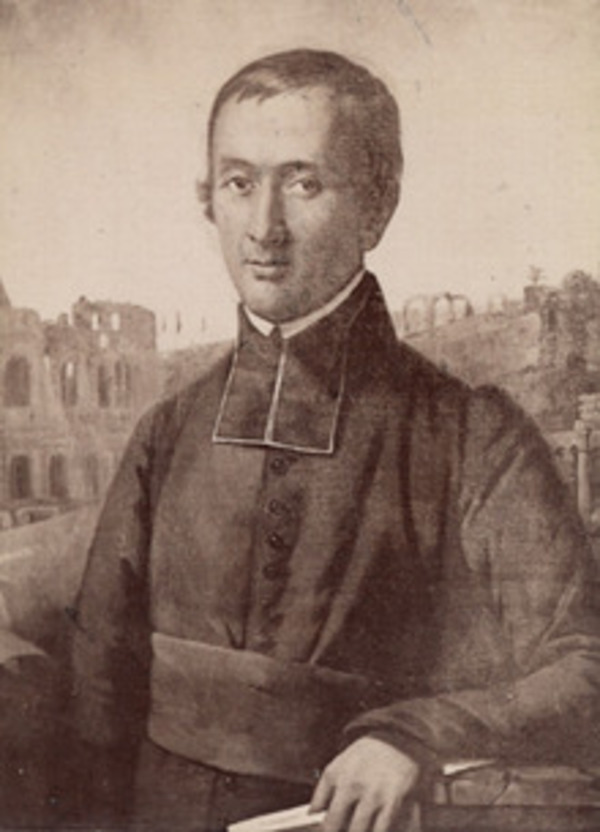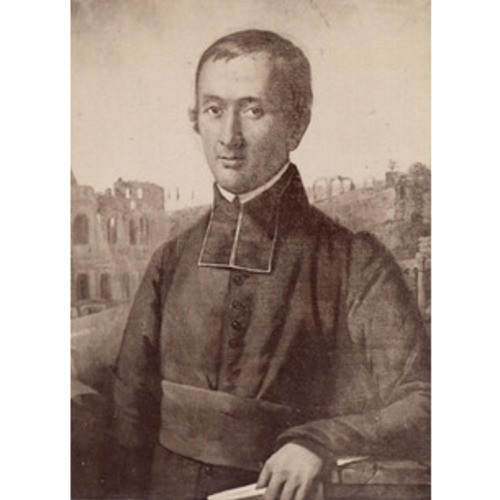
Source: Link
GINGRAS, LÉON, Roman Catholic priest, educator, seminary administrator, and author; b. 5 Aug. 1808 at Quebec, son of Pierre Gingras, a tavern-keeper, and Marguerite Gaboury and brother of Édouard; d. 18 Feb. 1860 in Paris.
Léon Gingras went through the various stages of classical studies at the Petit Séminaire de Québec from 1820 to 1828. According to a friend’s statement in L’Abeille, the seminary’s newspaper, he was a brilliant student and was often awarded the first prize at the end of the year. Because of his piety, the young man was drawn to the priesthood and from 1828 to 1831 he studied theology at the Grand Séminaire de Québec. He was ordained priest on 21 Aug. 1831. His liking for intellectual work and teaching kept him at the seminary, inclining him to the studious life of a teaching priest rather than to parish ministry.
At first Gingras was assigned the task of teaching the fourth form (Versification), but in 1832 he was made professor of theology and in 1833 was appointed in addition principal of the Grand Séminaire; he carried out these responsibilities until 1840. He was principal of the Petit Séminaire and prefect of studies from 1840 to 1842, and from 1842 to 1844 he again occupied the post of principal of the Grand Séminaire.
Exhausted from hard work and illness, Gingras left for Europe on 18 May 1844 with a friend (possibly Narcisse Bélanger). He was fulfilling a wish cherished from the time of his introduction to the life of the mind: “I had but begun my education when my thoughts and desires turned to the diverse countries where the great deeds of ancient and modern history have come to pass.” After a 34-day crossing, Gingras and his companion hastened to Paris, where he paid a visit to one of the authors whose books had delighted him as a young student, François-René de Chateaubriand. Six years earlier Chateaubriand had left the villa adjoining the Infirmerie Marie-Thérèse, an establishment run by his wife to care for aged priests, and moved to 120 Rue du Bac. It was there that, as Gingras noted, “the immortal author of Les martyrs deigned to honour us with his welcome.” From Paris, travelling through Lyons and Marseilles in France, and Milan, Venice, Assisi, and Rome in Italy, the two made their way to Sicily, to the island of Malta, and then to Egypt, where they landed at Alexandria.
Europe did not hold Gingras’s attention for long: “The Orient alone engaged my thoughts; it alone absorbed them completely.” Having joined a caravan, Gingras and his companion journeyed from Egypt to Mount Sinai, which they reached on 25 Feb. 1845. The Quebec priest climbed it Bible in hand. “Everything about this mountain,” he later wrote, “confirms Moses’s account; no prejudices, no scepticism, can hold up in the face of so many testimonies to truth.” Continuing on their way, the pilgrims reached Jerusalem on 14 March; the faithful reader of Chateaubriand explored the city, tracing the footsteps outlined in L’itinéraire de Paris à Jérusalem. On Easter Day he celebrated mass in the Church of the Holy Sepulchre: “The fact of my being a Canadian, together with the thought that I was the first priest from Canada to whom it had thus far been given to offer the holy mysteries in the tomb of Jesus Christ, contributed in no small measure to my already vivid impressions.”
From Jerusalem, the travellers crossed Galilee and went to Beirut, where they embarked on 3 April for Smyrna, Istanbul, and Athens. They came back through Austria, Germany, and Belgium, to Liverpool in England, and reached Quebec in July 1845.
Shortly after his return Gingras resumed his duties as principal of the Grand Séminaire, a post he held along with that of professor of philosophy and theology from 1845 to 1849. The following year he was appointed to the council of the bishop of Quebec, with, among others, his colleague Antoine Parant; Gingras kept this office until his death. He once more discharged the duties of principal of the Grand Séminaire from 1854 until May 1859, when he again set off for Europe to recover his health. But he was overcome by illness in Paris and died at the Infirmerie Marie-Thérèse on 18 Feb. 1860. His remains were buried in the cemetery of Montparnasse but were later brought back to Quebec and interred on 28 Aug. 1863 in the vault of the seminary chapel.
In 1847 Gingras had published at Quebec L’Orient ou voyage en Égypte, en Arabie, en Terre-Sainte, en Turquie et en Grèce, a two-volume work. After more than a century, the 1,028 pages can still be read with interest. Gingras had gathered his material with great care, as is evident from the authors he quotes. As well as the work of Chateaubriand, he mentions in a number of places the Pèlerinage à Jérusalem et au mont Sinaï, published in Paris between 1834 and 1836 by Baron Ferdinand de Géramb, a Trappist; Jean-Joseph-François Poujoulat’s L’histoire de Jérusalem, a work brought out in 1841 which he noted was “of the greatest use” to him; the geographical publications of Conrad Malte-Brun; and Alphonse de Lamartine’s Voyage en Orient. Gingras deeply regretted that the celebrated poet had set out on his journey as a Christian and had returned a deist.
Gingras, a Catholic priest of Lower Canada in the 19th century, naturally shared the prejudices of his time, of those of his station in life, and of the authors in whom he put his trust. It is far too easy, at more than 130 years’ distance, to write as Jean Ouellette did in an analysis of his work that, although Gingras showed “considerable sympathy towards the Jews and Jewish religion,” by contrast, “towards the other ethnic or religious groups that made up the Palestinian society of the time” he “displayed in general a crass intolerance and did not even seek to disguise his hostile feelings.” These lines are over harsh in their judgement, but Ouellette speaks with greater equanimity and justice in observing that Gingras’s testimony “is not devoid of interest for Orientalists in search of data experienced at first hand in a region of the world which is now in the spotlight.”
Léon Gingras expressed himself in a language that was usually correct. His long familiarity with the best French writers of the day gave his style elegance, variety, and precision. Consequently, comments by critic Edmond Lareau* on “the defects of style and the inadequacy of the form” that he believes he discovered in Gingras’s work reveal a manifest lack of sympathy or even of simple fairness.
Léon Gingras is the author of L’Orient ou voyage en Égypte, en Arabie, en Terre-Sainte, en Turquie et en Grèce (2v., Québec, 1847).
AAQ, 12 A, K, f.171v. ANQ-Q, CE1-1, 5 août 1808, 28 août 1863. ASQ, mss 437: 225–27. Le Séminaire de Québec: documents et biographies, Honorius Provost, édit. (Québec, 1964). L’Abeille, 15, 22 mars 1860. Allaire, Dictionnaire, 1: 242. DOLQ, 1: 555. Morgan, Sketches of celebrated Canadians, 411–12. P.-G. Roy, Fils de Québec, 3: 142–44. Tanguay, Répertoire (1893), 207. Lareau, Hist. de la littérature canadienne, 168–70. “Les disparus,” BRH, 36 (1930): 365. Jean Ouellette, “La Palestine au xixe siècle vue par un voyageur de Québec,” Centre de recherche en civilisation canadienne-française, Bull. (Ottawa), 19 (déc. 1979): 15–22.
Cite This Article
Philippe Sylvain, “GINGRAS, LÉON,” in Dictionary of Canadian Biography, vol. 8, University of Toronto/Université Laval, 2003–, accessed April 24, 2025, https://www.biographi.ca/en/bio/gingras_leon_8E.html.
The citation above shows the format for footnotes and endnotes according to the Chicago manual of style (16th edition). Information to be used in other citation formats:
| Permalink: | https://www.biographi.ca/en/bio/gingras_leon_8E.html |
| Author of Article: | Philippe Sylvain |
| Title of Article: | GINGRAS, LÉON |
| Publication Name: | Dictionary of Canadian Biography, vol. 8 |
| Publisher: | University of Toronto/Université Laval |
| Year of revision: | 1985 |
| Access Date: | April 24, 2025 |



